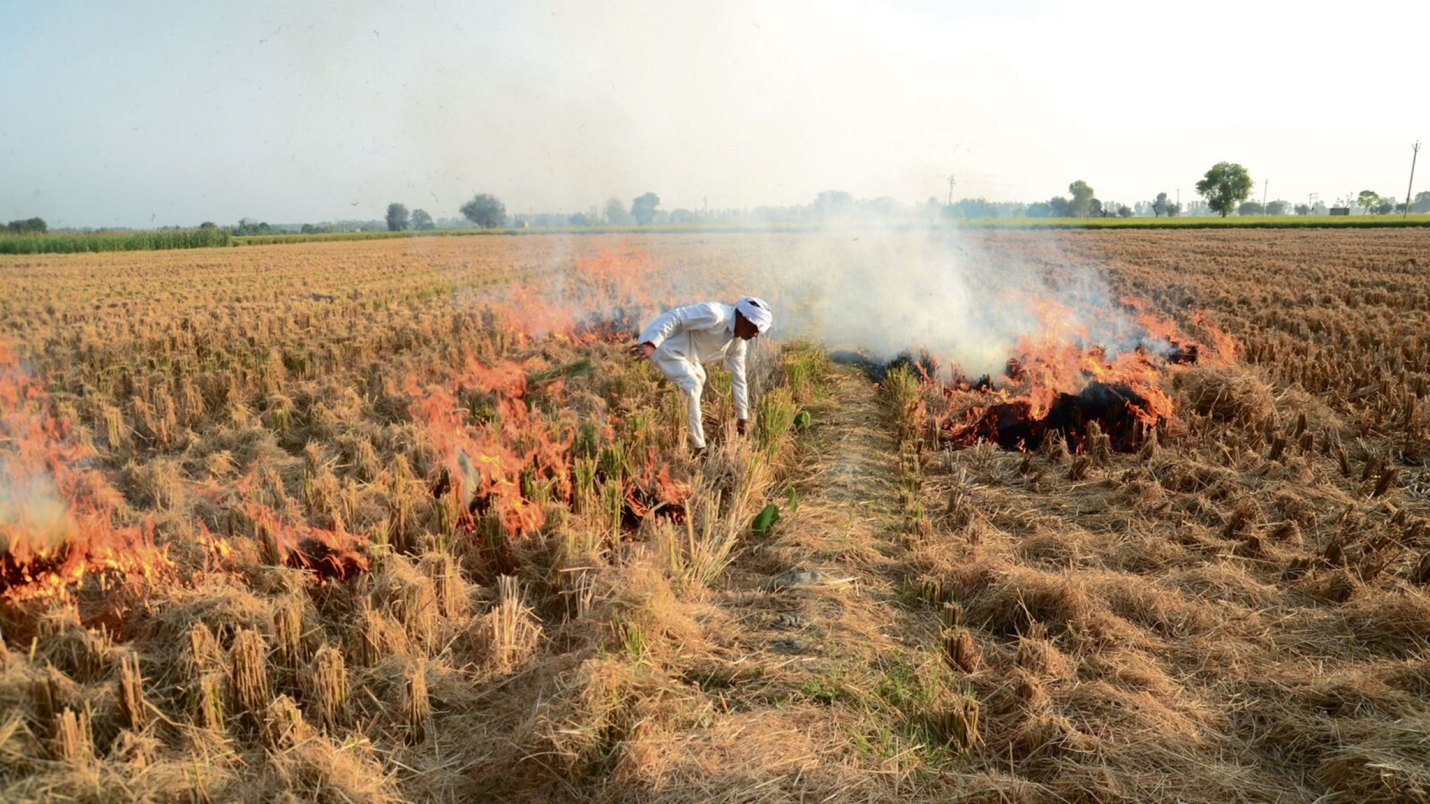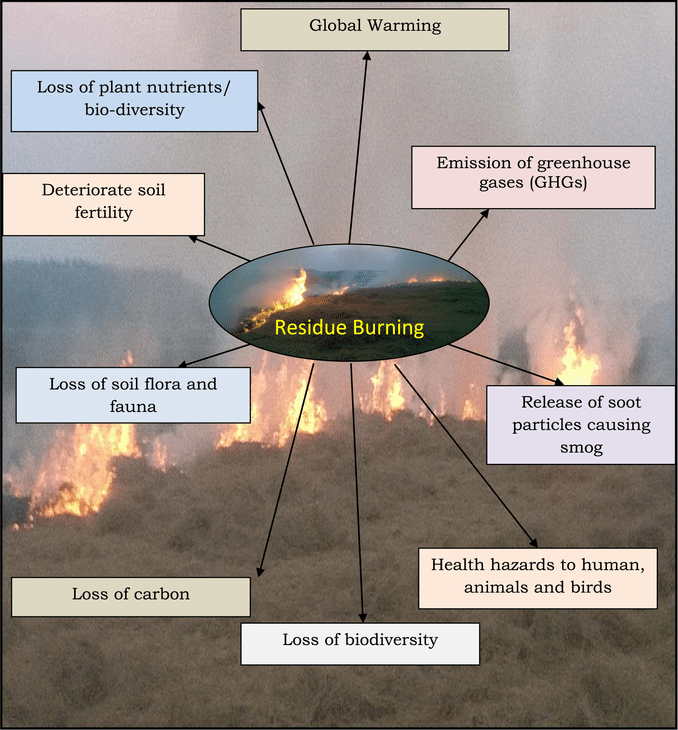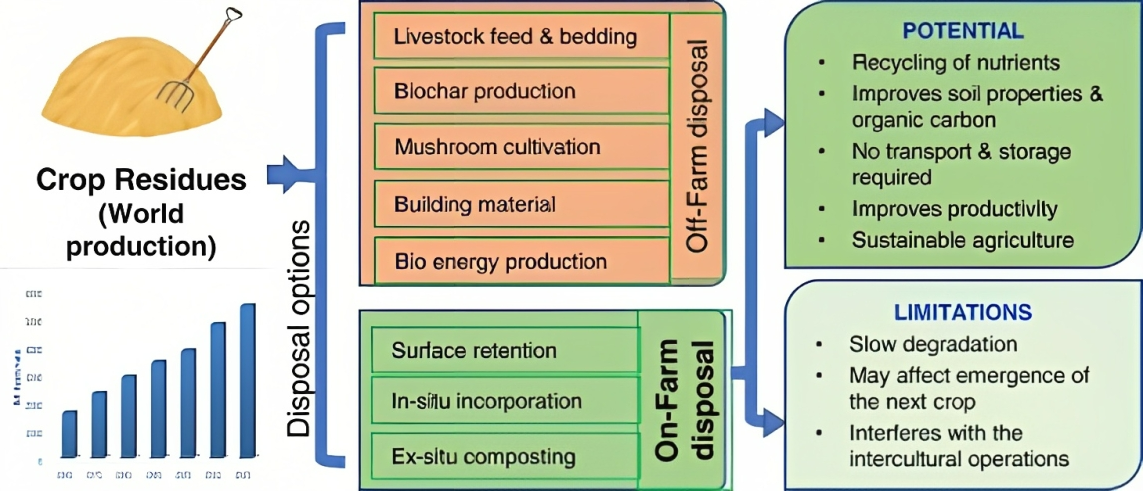
Copyright infringement not intended
Context: The Union Government has revised Crop Residue Management guidelines for efficient ex-situ management of paddy straw. The guidelines allow for techno-commercial pilot projects for the Paddy Straw Supply Chain to be set up under the bilateral agreement between the Beneficiary/Aggregator (Farmers, rural entrepreneurs, Cooperative Societies of Farmers, Farmers Producer Organizations (FPOs) and Panchayats) and Industries that use the paddy straw.
Details
- The Government will provide financial assistance on the capital cost of machinery and equipment required for the project.
- The working capital can be financed either jointly by the Industry and Beneficiary or through the Agriculture Infrastructure Fund (AIF), NABARD Financial or Financing from the Financial Institutions by the beneficiary.
- The beneficiary will also arrange and prepare the land for storage of the collected paddy straw as per the guidance of the end-use industry.
- The project proposal-based financial assistance will cover machines and equipment such as Higher HP Tractor, Cutters, Tedder, Medium to Large Balers, Rakers, Loaders, Grabbers and Telehandlers that are essential for establishing a paddy straw supply chain.
- The State Governments will approve these projects through a project sanctioning committee.
- The interventions will cover four states: Punjab, Haryana, Uttar Pradesh and Madhya Pradesh, where paddy straw burning is prevalent.
Objectives
- To reduce the practice of burning crop residue in the fields, which causes air pollution and health hazards.
- Collecting the surplus paddy straw from the farmers and transporting it to biomass collection depots, where it can be stored and processed for various end uses.
Funding pattern
- The Government (jointly by Central and State Governments) will fund 65% of the project cost, Industry as the main promoter of the project will fund 25% and will act as the Primary consumer of the feedstock collected.
- Farmers or groups of Farmers or Rural Entrepreneurs Cooperative Societies of Farmers or Farmers Producer Organizations (FPOs), or Panchayats will be the direct Beneficiary of the project and will fund the remaining 10%.
Expected outcomes of the interventions are:
- Collect about 1.5 million metric tonnes of paddy straw in three years, which would otherwise be burnt and emit harmful gases into the atmosphere.
- Create about 333 biomass collection depots with a capacity of 4500 MT each, where the paddy straw will be sorted, baled and compressed for easy handling and transportation.
- Reduce the air pollution caused by stubble burning, which affects the air quality and health of millions of people in the region and beyond.
- Generate employment opportunities for about 9, 00,000 man-days, as the collection, transportation and processing of paddy straw will require skilled and unskilled labour.
- Support the development of a robust supply chain for paddy straw, which will enable its utilization for various purposes such as power generation, heat generation, bio-CNG, bio-ethanol, etc. by different industries and sectors.
- Encourage new investments in biomass to biofuel and energy sectors, as the availability of paddy straw will create a demand for its conversion into valuable products.

Crop Residue Management
About
- Crop residue management is the practice of managing the plant materials that remain in the field after harvesting crops. It involves decisions about whether to retain, remove, burn, incorporate, or use the residues for various purposes.
- Crop residue management has implications for soil health, crop productivity, environmental quality, and rural livelihoods.
Crop residues can provide multiple benefits
- Protect the soil from erosion and water loss.
- Enhance soil organic matter and fertility.
- Suppress weeds and pests.
- Provide feed and bedding for livestock.
- Serve as raw materials for bioenergy and bioproducts.
Why Crop residues are often underutilized or mismanaged?
- Lack of awareness or knowledge about the benefits and methods of crop residue management.
- Limited availability or affordability of appropriate machinery and equipment.
- Incentives or policies that favour residue removal or burning.
- Trade-offs or conflicts between different uses and users of residues.
- Cultural or social norms that influence residue management practices.
Not a one-size-fits-all solution. It depends on various factors, such as:
- The type, amount, and quality of residues produced by different crops and cropping systems.
- The soil type, climate, and topography of the field.
- The objectives and preferences of the farmer and other stakeholders.
- The availability and accessibility of markets and services for residue utilization.
Therefore, crop residue management requires a holistic and integrated approach that considers the whole farm system and its interactions with the environment and society. It also requires adaptive management that responds to changing conditions and needs.
Methods of crop residue management
Retention
- Keeping the residues on the field, either on the surface or partially incorporated into the soil. This can be done by using no-till or conservation tillage practices, mulching, or cover cropping.
Removal
- Taking the residues away from the field, either for off-farm use or disposal. This can be done by harvesting, baling, or raking the residues.
Burning
- Setting fire to the residues on the field, either intentionally or accidentally. This can be done by using slash-and-burn practices, controlled burns, or uncontrolled fires.
Utilization
- Using the residues for various purposes, either on-farm or off-farm. This can be done by feeding or bedding livestock, composting or vermicomposting, producing bioenergy or bioproducts, or applying organic fertilizer.

Some of the widely used methods are:
No-till or conservation tillage
- This method involves planting crops directly into the previous crop residue without ploughing or disturbing the soil. This can help reduce soil erosion, conserve soil moisture, improve soil structure and fertility, and sequester carbon.
Mulching
- This method involves covering the soil surface with crop residue or other organic materials to protect it from wind and water erosion, evaporation, weed growth, and temperature fluctuations. This can help improve soil quality, conserve water, suppress weeds, and enhance crop growth.
Composting
- This method involves decomposing crop residue or other organic wastes into a stable and nutrient-rich material that can be used as a soil amendment or fertilizer. This can help recycle nutrients, improve soil health, reduce waste disposal costs, and mitigate greenhouse gas emissions.
Biofuel production
- This method involves converting crop residue or other biomass into liquid or gaseous fuels that can be used for transportation, heating, cooking, or electricity generation. This can help diversify energy sources, reduce fossil fuel dependence, create rural employment opportunities, and lower greenhouse gas emissions.
Crop residue management has positive impacts
Improved soil health and function
- Crop residues can increase soil organic matter, water-holding capacity, nutrient cycling, biological activity, and structure. This can improve soil quality and resilience, reduce soil degradation and compaction, and enhance soil biodiversity.
Increased crop productivity and profitability
- Crop residues can improve soil fertility, water availability, weed and pest control, and microclimate. This can increase crop yields and quality, reduce input costs and risks, and increase farm income and profitability.
Reduced greenhouse gas emissions and air pollution
- Crop residues can sequester carbon in the soil, reduce nitrous oxide emissions from fertilizers, and avoid methane emissions from rice paddies. They can also reduce emissions of carbon dioxide, black carbon, particulate matter, and other pollutants from residue burning.
Enhanced ecosystem services and biodiversity
- Crop residues can provide habitat and food for wildlife, pollinators, and beneficial insects. They can also regulate water flow and quality, moderate temperature extremes, buffer against natural disasters, and support cultural values.

Challenges that need to be addressed
Lack of awareness and incentives
- Many farmers are unaware of the benefits of crop residue management or lack the motivation to adopt it. They may perceive it as a waste of time, labour, or money, or as a threat to their traditional practices.
- There are often no adequate incentives or policies to encourage or support farmers to adopt crop residue management practices.
Lack of infrastructure and technology
- Another challenge is the lack of adequate infrastructure and technology for crop residue management. For example, there may be no proper storage facilities, transportation systems, or markets for crop residues.
- There may also be no suitable machinery or equipment for collecting, processing or utilizing crop residues.
Trade-offs and conflicts
- Crop residue management may also involve trade-offs and conflicts among different stakeholders and objectives. For example, some farmers may prefer to burn crop residues to clear the land quickly and cheaply, but this may cause air pollution and health problems for others.
- Similarly, some farmers may want to use crop residues as animal feed or bedding, but this may reduce the availability of organic matter for soil improvement.
To overcome these challenges and promote crop residue management, there is a need for a holistic and integrated approach that involves multiple actors and sectors.
Some possible ways forward are:
Raising awareness and providing incentives
- Raise awareness and provide incentives for farmers and other stakeholders to adopt crop residue management practices. This can be done through extension services, education programs, demonstration plots, media campaigns, subsidies, rewards, or regulations.
Developing infrastructure and technology
- Develop infrastructure and technology for crop residue management. This can be done through research and innovation, public-private partnerships, investment, or cooperation. For example, there can be efforts to develop and disseminate low-cost and efficient machinery or equipment for crop residue collection, processing, or utilization. There can also be efforts to create and expand storage facilities, transportation systems, or markets for crop residues.
Balancing trade-offs and resolving conflicts
- Balance trade-offs and resolve conflicts among different stakeholders and objectives. This can be done through dialogue, negotiation, participation, or collaboration. For example, there can be efforts to find win-win solutions that benefit both farmers and the environment, such as using crop residues for bioenergy production or composting.
- There can also be efforts to involve and empower local communities and institutions in the decision-making and implementation of crop residue management practices.

Conclusion
- Crop residue management can contribute to sustainable agriculture, food security, environmental protection, and climate change mitigation and adaptation. However, there are still many challenges and barriers that hinder its adoption and scaling up. Therefore, there is a need for a comprehensive and integrated approach that involves raising awareness and capacity, providing incentives and policies, developing infrastructure and markets, and strengthening coordination and collaboration among different stakeholders.
Must-Read Articles:
STUBBLE BURNING: https://www.iasgyan.in/daily-current-affairs/stubble-burning-29
|
PRACTICE QUESTION
Q. Which of the following is/are the benefits of crop residue mulching?
1. It conserves soil moisture and reduces evaporation
2. It suppresses weeds and reduces herbicide use
3. It moderates soil temperature and prevents frost damage
Choose the correct code;
A) 1 and 2 only
B) 2 and 3 only
C) 1 and 3 only
D) 1, 2 and 3
Answer: D
Explanation: Crop residue mulching is the application of a layer of crop residues on the soil surface to cover it partially or completely. This can help conserve soil moisture and reduce evaporation, suppress weeds and reduce herbicide use, moderate soil temperature and prevent frost damage.
|
https://pib.gov.in/PressReleasePage.aspx?PRID=1936626






